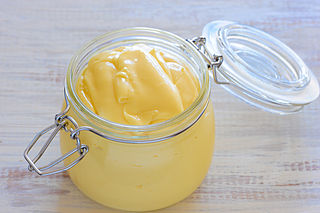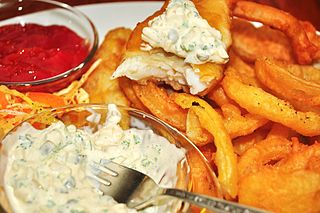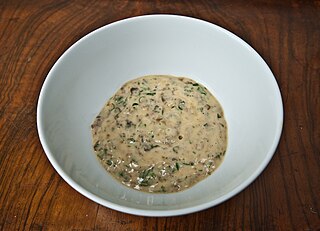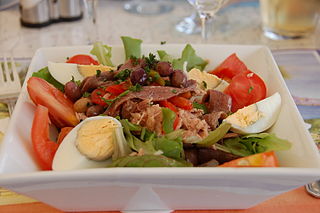
A Caesar salad is a green salad of romaine lettuce and croutons dressed with lemon juice, olive oil, egg, Worcestershire sauce, anchovies, garlic, Dijon mustard, Parmesan cheese, and black pepper.

Mayonnaise, colloquially referred to as "mayo", is a thick, cold, and creamy sauce commonly used on sandwiches, hamburgers, composed salads, and French fries. It also forms the base for various other sauces, such as tartar sauce, fry sauce, remoulade, salsa golf, ranch dressing, and rouille.

Tartar sauce is a condiment made of mayonnaise, chopped pickles and relish, caper, and herbs such as tarragon and dill. Tartar sauce can also be enhanced with the addition of other varieties of herbs, lemon juice, or olives. It is most often served with seafood dishes such as fish and chips, fish sandwiches, fish fingers, fried oysters, and calamari.

Fines herbes designates an important combination of herbs that forms a mainstay of French cuisine. The canonical fines herbes of French haute cuisine comprise finely chopped parsley, chives, tarragon, and chervil. These are employed in seasoning delicate dishes, such as chicken, fish, and eggs, that need a relatively short cooking period; they may also be used in a beurre blanc sauce for seasoning such dishes. Fines herbes are also eaten raw in salads.

A Waldorf salad is a fruit and nut salad generally made of celery, fresh apples, walnuts, and grapes, dressed in mayonnaise, and traditionally served on a bed of lettuce as an appetizer or a light meal. The apples, celery, and grapes can all be green, which harmonizes the color palette of the dish.

Russian dressing is a piquant American salad dressing consisting of mayonnaise, ketchup, and other ingredients.

Hollandaise sauce, meaning Dutch sauce in French, is a mixture of egg yolk, melted butter, and lemon juice. It is usually seasoned with salt, and either white pepper or cayenne pepper.

Green sauce or greensauce is a family of cold, uncooked sauces based on chopped herbs, including the Spanish and Italian salsa verde, the French sauce verte, the German grüne Soße or Frankfurter grie Soß, the British mint sauce and greensauce, and the Argentinian chimichurri.

Cheese fries or cheesy chips is a dish consisting of French fries covered in cheese, with the possible addition of various other toppings. Cheese fries are generally served as a lunch or dinner dish. They can be found in fast-food locations, diners, and grills mainly in English speaking countries.

Rémoulade is a cold sauce. Although similar to tartar sauce, it is often more yellowish, sometimes flavored with curry, and often contains chopped pickles or piccalilli. It can also contain horseradish, paprika, anchovies, capers and a host of other items.

Deviled eggs, also known as devilled eggs, Itlog ni Lee, stuffed eggs, Russian eggs, curried eggs or dressed eggs, are hard-boiled eggs that have been shelled, cut in half, and filled with a paste made from the egg yolks mixed with other ingredients such as mayonnaise and mustard. They are generally served cold as a side dish, appetizer or a main course during gatherings or parties. The dish's origin can be seen in recipes for boiled, seasoned eggs as far back as ancient Rome, where they were traditionally served as a first course. The dish is popular in Europe, North America and Australia.

Louis dressing is a salad dressing based on mayonnaise, to which red chili sauce, minced green onions, and minced green chili peppers have been added. It is commonly used as a dressing for salads featuring seafood, such as a crab or shrimp.

A dip or dip sauce is a common condiment for many types of food. Dips are used to add flavor or texture to a food, such as pita bread, dumplings, crackers, chopped raw vegetables, fruits, seafood, cubed pieces of meat and cheese, potato chips, tortilla chips, falafel, and sometimes even whole sandwiches in the case of jus. Unlike other sauces, instead of applying the sauce to the food, the food is typically placed or dipped into the sauce.

Salade niçoise, salada nissarda in the Niçard dialect of the Occitan language, insalata nizzarda in Italian, is a salad that originated in the French city of Nice. It is traditionally made of tomatoes, hard-boiled eggs, Niçoise olives and anchovies or tuna, dressed with olive oil, or in some historical versions, a vinaigrette. It has been popular worldwide since the early 20th century, and has been prepared and discussed by many chefs. Delia Smith called it "one of the best combinations of salad ingredients ever invented" and Gordon Ramsay said that "it must be the finest summer salad of all".

Chef salad is an American salad consisting of hard-boiled eggs, one or more varieties of meat, tomatoes, cucumbers, and cheese, all placed upon a bed of tossed lettuce or other leaf vegetables. Several early recipes also include anchovies. A variety of dressings may be used with this salad.

Chinese chicken salad is a salad including chopped chicken and Chinese culinary ingredients that is common in parts of the United States. Though many variations exist, common features of Chinese chicken salads include lettuce, cabbage, carrots, cucumbers, chicken, deep-fried wonton skins or rice vermicelli and nuts. A basic vinaigrette for the salad includes ingredients like vegetable oil, sesame oil, rice vinegar. Optional seasonings include dry hot mustard, sesame seeds, coriander and raw ginger or pickled ginger. In restaurants, Chinese chicken salad may be more embellished and offered as an American-style entree salad, similar to Caesar, Chef, and Cobb salads.

Crab Louie salad, also known as Crab Louis salad or the King of Salads, is a type of salad featuring crab meat. The recipe dates back to the early 1900s and originates on the West Coast of the United States.

Olivier salad is a traditional salad dish in Russian cuisine, which is also popular in other post-Soviet countries and around the world. In different modern recipes, it is usually made with diced boiled potatoes, carrots and brined dill pickles, together with optional vegetable or fruit ingredients such as green peas, eggs, celeriac, onions and apples, optional meat ingredients such as diced boiled chicken, bologna sausage, ham, or hot dogs, with salt, pepper and mustard sometimes added to enhance flavor, and dressed with mayonnaise. In many countries, the dish is commonly referred to as Russian salad, in Brazil it is called Maionese, in a few Scandinavian countries it is called italiensk salat and in Dutch it is called huzarensalade. In former Yugoslavian countries it is called ruska salata or francuska salata. In Romania it is known as "salata (de) boeuf."

Thousand Island dressing is an American salad dressing and condiment based on mayonnaise that can include olive oil, lemon juice, orange juice, paprika, Worcestershire sauce, mustard, vinegar, cream, chili sauce, tomato purée, and ketchup or Tabasco sauce. It also typically contains finely chopped ingredients, which can include pickles, onions, bell peppers, green olives, hard-boiled egg, parsley, pimento, chives, garlic, or chopped nuts.



















